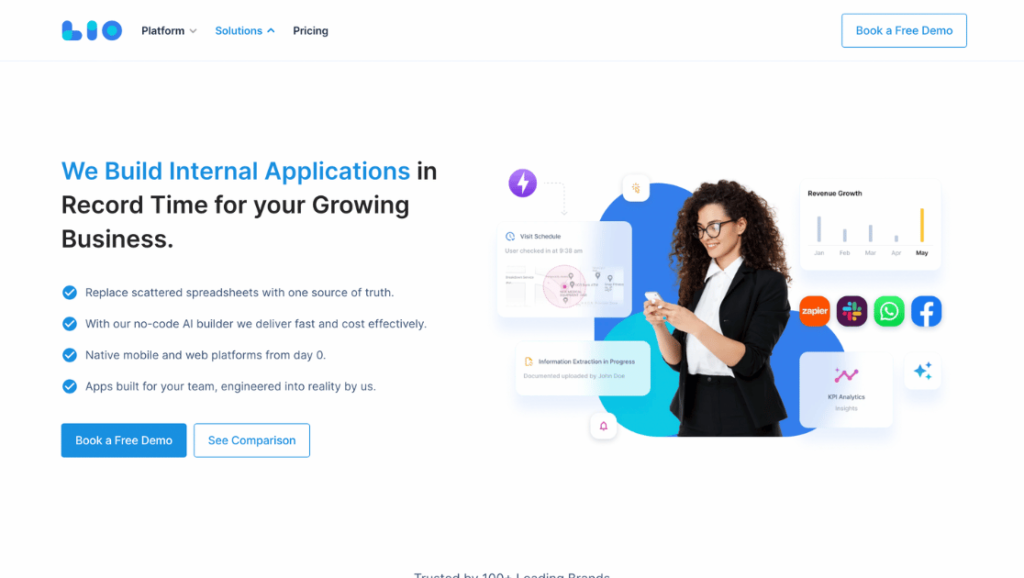What are Digital Work Instructions?
Gaurav Singh Rawat
- April 9, 2025
- 19 Min Read

In today’s fast-paced industrial landscape, the efficiency and reliability of assets are paramount to the success of any organization.
Asset health monitoring has emerged as a crucial practice that enables companies to optimize their asset performance, minimize downtime, and reduce maintenance costs.
By leveraging advanced technologies and data-driven insights, asset health monitoring provides a proactive approach to asset management, ensuring that equipment operates at peak performance and potential issues are identified before they lead to costly failures.
Definition of Digital Work Instructions
Digital work instructions are electronic versions of work instructions, quality manuals, or SOPs that provide necessary visual aids and real-time contextual information to help guide workers through complex tasks.
They are typically used on computers, mobile devices, or wearables, and include step-by-step instructions combined with visual aids, contextual information aggregated from external sources, and sometimes augmented reality (AR) or mixed reality (MR) experiences.
Importance of digital work instructions in modern manufacturing
The importance of digital work instructions in modern manufacturing cannot be overstated. They help manage increasing product complexity, reduce human error, facilitate faster training and onboarding, enable easier updating and version control, and provide valuable data for continuous improvement.
Digital work instructions play a key role in the overall knowledge database and are a key enabler of the digital transformation in manufacturing, helping companies optimize their operations and prepare for the future of work.
As Industry 4.0 technologies continue to advance, digital work instructions will become even more critical in capturing the expertise of experienced workers and delivering it to the next generation.
By leveraging the latest technologies and following best practices for implementation, manufacturers can unlock significant benefits in productivity, quality, and workforce development with digital work instructions. Now is the time to embrace this powerful technology and transform the way instructions are delivered to the frontline workforce.

Digitize Work Instructions Now
Transform your operations with our user-friendly digital work instructions software. Boost productivity, reduce errors, and streamline training. Get started today!
The Benefits of Digital Work Instructions
Digital work instructions offer numerous advantages over traditional paper-based instructions in manufacturing environments. By leveraging digital technologies, companies can significantly improve productivity, communication, training, version control, and quality. Let’s explore the key benefits of implementing digital work instructions.
Increased productivity and efficiency
One of the primary benefits of digital work instructions is the boost in productivity and efficiency they provide. With instant access to up-to-date instructions on mobile devices or computers, workers spend less time searching for information and more time focusing on their tasks.
Digital work instructions also enable workers to quickly navigate through steps, reducing the time spent on each task. Moreover, the ability to integrate digital work instructions with other systems, such as ERP or MES, streamlines workflows and eliminates manual data entry, further enhancing efficiency.

Improved communication and collaboration
Digital work instructions greatly improve communication and collaboration among team members. By providing a centralized platform for creating, updating, and accessing instructions, digital work instructions ensure that everyone is working with the same information.
This is particularly beneficial for teams working across different shifts or locations. Additionally, digital work instructions often include features like commenting or feedback mechanisms, allowing workers to provide input and suggestions for continuous improvement.
Enhanced training and onboarding
Digital work instructions revolutionize the way companies train and onboard new employees. With interactive guides that include videos, images, and step-by-step instructions, new hires can quickly learn processes and procedures.
This reduces the time and resources required for traditional classroom training or shadowing experienced workers. Digital work instructions also provide a consistent training experience, ensuring that all employees receive the same high-quality information.
Furthermore, the ability to track employee progress and performance through digital work instructions helps identify areas where additional training may be needed.
Easier updating and version control
Maintaining and updating paper-based work instructions can be a time-consuming and error-prone process. Digital work instructions, on the other hand, make it simple to update and distribute the latest versions to all users instantly.
This ensures that workers always have access to the most current and accurate information. Version control features also allow companies to track changes, see who made updates, and revert to previous versions if needed. This level of control and transparency is crucial for maintaining quality and compliance in manufacturing settings.
Improved quality and reduced errors
Digital work instructions play a vital role in improving product quality and reducing errors on the shop floor. By providing clear, detailed, and visual guides, digital work instructions help workers perform tasks correctly and consistently.
This reduces the likelihood of mistakes caused by misinterpretation or reliance on memory. Additionally, digital work instructions can incorporate error-proofing measures, such as built-in checks or alerts, to prevent workers from proceeding if a step is missed or performed incorrectly.
By minimizing human error, companies can significantly reduce scrap, rework, and customer complaints, ultimately leading to improved quality and cost savings.
Key Features of Effective Digital Work Instructions
Digital work instructions have revolutionized the way companies provide guidance to their employees on the shop floor.
By leveraging technology, digital work instructions offer a more engaging, interactive, and accessible way to convey information compared to traditional paper-based instructions. To truly harness the power of digital work instructions, it’s essential to incorporate several key features that enhance their effectiveness and usability.

Go Paperless on the Shop Floor
Say goodbye to outdated paper instructions. Embrace the power of digital work instructions to improve quality, efficiency, and compliance. Learn more now.
Detailed, step-by-step instructions
One of the most crucial aspects of effective digital work instructions is the inclusion of detailed, step-by-step instructions. Breaking down complex processes into clear, concise steps helps workers understand and follow the instructions more easily.
Each step should focus on a single action, ensuring that the instructions are easy to digest and execute. By providing a logical sequence of steps, digital work instructions reduce the likelihood of errors and improve overall process consistency.
Visual aids like images, videos, and diagrams
Digital work instructions have a significant advantage over paper-based instructions in their ability to incorporate rich visual aids. Including images, videos, diagrams, and 3D models can greatly enhance the clarity and comprehension of the instructions.
Visual aids help workers better understand the tasks at hand, especially when dealing with complex or unfamiliar processes. They can also highlight key details, making it easier for workers to focus on critical aspects of the job. By leveraging the power of visual content, digital work instructions become more engaging and effective.
Interactivity and data collection
Digital work instructions offer the opportunity to make the content more interactive, further enhancing worker engagement and knowledge retention. Interactive elements such as clickable hotspots, quizzes, and simulations can help workers actively participate in the learning process.
Additionally, digital work instructions can incorporate data collection features, such as digital forms and checklists, allowing workers to input information directly into the system. This not only streamlines data capture but also enables real-time monitoring and analysis of process performance.
Mobile accessibility
In today’s fast-paced manufacturing environment, it’s crucial for workers to have access to digital work instructions at their point of need. Mobile accessibility ensures that workers can view the instructions on various devices, such as tablets and smartphones, without being tethered to a fixed workstation.
This flexibility allows workers to refer to the instructions whenever and wherever they need them, reducing the time spent searching for information and increasing overall efficiency. Mobile accessibility also facilitates on-the-job training, as workers can learn and reference the instructions while performing the actual tasks.
Integration with other systems
To maximize the potential of digital work instructions, it’s important to consider their integration with other systems and tools used in the manufacturing process. Integrating digital work instructions with enterprise resource planning (ERP) systems, manufacturing execution systems (MES), and Internet of Things (IoT) devices can create a seamless flow of information.
This integration allows for real-time updates, ensuring that workers always have access to the most current instructions. It also enables the automation of certain processes, such as triggering work instructions based on machine status or quality control data.
Implementing Digital Work Instructions
Implementing digital work instructions is a crucial step in modernizing and streamlining your manufacturing processes. To ensure a successful transition from traditional paper-based instructions to digital work instructions, there are several key factors to consider.

Simplify SOPs with Digital WI
Streamline your SOPs and make them easily accessible with our digital work instruction platform. Ensure consistency and compliance across your organization.
Choosing the right software platform
Selecting the right software platform is essential for the successful implementation of digital work instructions. When evaluating potential solutions, look for platforms that offer features such as easy authoring, seamless distribution, and robust data collection capabilities.
The ideal digital work instructions software should be user-friendly, scalable, and compatible with your existing systems and devices.
Best practices for creating instructions
Defining clear processes
Before creating digital work instructions, it’s essential to define clear, standardized processes for each task. Break down complex procedures into simple, logical steps that are easy for workers to follow. Collaborate with subject matter experts and experienced employees to ensure that the documented processes are accurate and efficient.
Using standardized formats
Consistency is key when creating digital work instructions. Develop a standardized format for your instructions, including the use of consistent terminology, icons, and visual elements. This uniformity helps workers quickly understand and navigate the instructions, reducing the likelihood of errors and confusion.
Incorporating visual aids
Visual aids are a powerful tool for enhancing the clarity and effectiveness of digital work instructions. Incorporate images, videos, diagrams, and 3D models to illustrate complex tasks and provide context for each step. Visual aids help workers grasp the information more quickly and retain it better than text-based instructions alone.
Optimizing for mobile devices
With the increasing use of mobile devices on the shop floor, it’s crucial to optimize your digital work instructions for these platforms. Ensure that the instructions are easily readable and navigable on smaller screens, and take advantage of mobile-specific features like touch interactions and voice commands. By designing your digital work instructions with mobile devices in mind, you enable workers to access the information they need anytime, anywhere.
Rolling out to the workforce
Training and onboarding
Once your digital work instructions are created, it’s time to roll them out to your workforce. Provide comprehensive training and onboarding sessions to familiarize workers with the new system. Demonstrate how to access and navigate the digital work instructions, and give employees hands-on practice using the software. Ensure that workers understand the benefits of using digital work instructions and how they can improve their daily tasks.
Encouraging adoption and feedback
To ensure the successful adoption of digital work instructions, it’s essential to actively encourage their use and solicit feedback from workers. Regularly communicate the importance of following the digital work instructions and highlight success stories where their use has led to improved outcomes.
Establish channels for employees to provide feedback and suggestions for improvement, and act on this input to refine your digital work instructions over time.
Continuously improving instructions
The implementation of digital work instructions is not a one-time event, but rather an ongoing process of continuous improvement. Regularly review and update your instructions based on worker feedback, process changes, and performance data. Leverage the analytics and reporting features of your digital work instructions software to identify areas for optimization and track the impact of your improvements.
By following these best practices for implementing digital work instructions, manufacturers can successfully transition from outdated paper-based systems to modern, efficient digital workflows. Embracing digital work instructions not only streamlines processes and reduces errors but also empowers workers with the knowledge and tools they need to excel in their roles.

Real-World Examples and Case Studies of Digital Work Instructions
Digital work instructions have proven to be a game-changer across various industries, revolutionizing the way companies approach manufacturing, assembly, and training. By implementing digital work instructions, businesses have seen significant improvements in efficiency, quality, and employee performance.
Let’s explore some real-world examples and case studies that demonstrate the impact of digital work instructions in different sectors.

Upgrade to Digital Instructions
Take your manufacturing processes to the next level with our cutting-edge digital work instructions. Integrate with your existing systems for seamless adoption.
Digital work instructions in automotive manufacturing
The automotive industry has been quick to adopt digital work instructions to streamline their manufacturing processes. For example, a leading automotive manufacturer implemented digital work instructions on their assembly lines, resulting in a 20% increase in productivity and a 50% reduction in errors.
By providing workers with clear, step-by-step instructions and visual aids, the company was able to ensure consistent quality and reduce the time spent on each task. Additionally, the digital work instructions enabled the manufacturer to easily update and distribute changes to the assembly process, ensuring that all workers were always using the most current information.
Improving efficiency in aerospace assembly
Aerospace manufacturing is known for its complex assembly processes and stringent quality requirements. Digital work instructions have proven to be a valuable tool in this industry, helping companies improve efficiency and reduce errors. In one case study, an aerospace manufacturer implemented digital work instructions for the assembly of a critical component.
By using 3D models, animations, and interactive guides, the company was able to reduce the assembly time by 30% and eliminate defects caused by human error. The digital work instructions also made it easier to train new employees, as they could follow the step-by-step instructions and learn the process more quickly.
Enhancing training in the food and beverage industry
The food and beverage industry faces unique challenges when it comes to training employees and ensuring consistent product quality. Digital work instructions have been successfully used to address these challenges and enhance training programs. For instance, a major food processing company implemented digital work instructions to train new employees on food safety protocols and standard operating procedures.
By using interactive guides and videos, the company was able to reduce training time by 50% and improve employee retention of the information. Additionally, the digital work instructions helped the company maintain consistent product quality by ensuring that all employees followed the same procedures and best practices.
The Future of Digital Work Instructions
As technology continues to advance at a rapid pace, the future of digital work instructions looks incredibly promising.
The integration of emerging technologies such as artificial intelligence, machine learning, augmented and virtual reality, and the Internet of Things will revolutionize the way digital work instructions are created, delivered, and utilized in various industries.

Integration with emerging technologies
Artificial intelligence and machine learning
The incorporation of artificial intelligence (AI) and machine learning (ML) into digital work instructions will enable the creation of more intelligent and adaptive systems.
AI-powered digital work instructions can analyze user behavior, identify patterns, and provide personalized guidance based on individual needs and skill levels. Machine learning algorithms can continuously improve the effectiveness of instructions by learning from user interactions and feedback.
Augmented and virtual reality
Augmented reality (AR) and virtual reality (VR) technologies will take digital work instructions to the next level by providing immersive and interactive experiences. AR-enabled digital work instructions can overlay real-time information, 3D models, and step-by-step guidance directly onto the user’s view of the physical world, enhancing comprehension and reducing errors.
VR simulations can be used for training purposes, allowing users to practice complex tasks in a safe and controlled environment before applying their skills in real-world situations.
Internet of Things and smart devices
The Internet of Things (IoT) and smart devices will play a crucial role in the future of digital work instructions. By connecting various devices, sensors, and machines, digital work instructions can access real-time data and provide context-aware guidance.
For example, smart tools can communicate with digital work instructions to ensure that the correct torque settings are applied during assembly processes, while wearable devices can monitor user fatigue and suggest breaks when necessary.
Potential impact on the workforce
The adoption of advanced digital work instructions will have a significant impact on the workforce. As machines and algorithms take over repetitive and mundane tasks, human workers will need to focus on higher-value activities that require creativity, problem-solving, and emotional intelligence.
This shift may lead to the creation of new job roles and the need for upskilling and reskilling programs to prepare workers for the future.
Importance of digital skills for future jobs
As digital work instructions become more sophisticated and integrated with emerging technologies, the importance of digital skills for future jobs cannot be overstated.
Workers will need to be proficient in using and interacting with digital tools, platforms, and interfaces. They will also need to develop a strong understanding of data analysis, problem-solving, and continuous learning to adapt to the ever-changing technological landscape.
Organizations that invest in digital skill development and provide ongoing training opportunities will be better positioned to harness the full potential of digital work instructions and remain competitive in the future.
How Lio Can Help Industries with Digital Work Instructions
Lio is a powerful platform that enables businesses to create custom enterprise applications powered by AI. One of the key areas where Lio can make a significant impact is in the implementation of digital work instructions across various industries.
Here’s how Lio can help industries streamline their operations with digital work instructions:

Rapid Application Development
Lio’s AI-powered platform allows businesses to develop custom applications for digital work instructions in a matter of days. This rapid development process eliminates the need for lengthy and expensive software development cycles, enabling industries to quickly digitize their work instructions and start reaping the benefits.
Seamless Integration
Lio seamlessly integrates with over 100 existing applications, making it easy for industries to connect their digital work instructions with their current systems and workflows. This integration ensures a smooth transition from traditional paper-based instructions to digital ones, minimizing disruption to ongoing operations.
Customizable Workflows
With Lio, industries can create custom workflows tailored to their specific needs. This flexibility allows businesses to digitize their work instructions in a way that aligns with their unique processes, ensuring maximum efficiency and ease of use for their employees.
Mobile Accessibility
Lio enables industries to access their digital work instructions on various devices, including smartphones and tablets. This mobile accessibility empowers frontline workers to access the information they need, when and where they need it, leading to improved productivity and reduced errors on the shop floor.
Real-Time Updates and Collaboration
Lio facilitates real-time updates and collaboration, allowing teams to make changes to digital work instructions as processes evolve. This feature ensures that all employees have access to the most up-to-date information, fostering a culture of continuous improvement and knowledge sharing.
Data-Driven Insights
By digitizing work instructions with Lio, industries can capture valuable data on process execution and employee performance. This data can be analyzed to identify bottlenecks, optimize processes, and drive continuous improvement initiatives, ultimately leading to increased efficiency and cost savings.

Integrate & Automate with Lio
Connect Lio with your existing tech stack seamlessly. Configure API endpoints, webhooks, and third-party integrations to streamline your operations.
Conclusion
The benefits of implementing digital work instructions are numerous and far-reaching. From increased productivity and improved quality to enhanced training and better knowledge retention, digital work instructions offer a comprehensive solution to many of the challenges faced by modern manufacturers. By providing workers with clear, visual, and interactive instructions, companies can ensure that every task is completed consistently and accurately, regardless of the operator’s experience level.
As the manufacturing industry continues to evolve and embrace the principles of Industry 4.0, the adoption of digital work instructions will become increasingly critical for staying competitive and meeting the demands of the future. With the integration of advanced technologies such as artificial intelligence, augmented reality, and the Internet of Things, digital work instructions will become even more powerful and transformative, enabling companies to unlock new levels of efficiency, flexibility, and innovation.
In conclusion, the future of manufacturing belongs to those who embrace the power of digital work instructions and harness their potential to drive continuous improvement and operational excellence. By investing in the right tools, technologies, and best practices for creating and deploying digital work instructions, companies can position themselves for success in the era of smart manufacturing and lay the foundation for a more productive, agile, and sustainable future.
Frequently Asked Questions (FAQs)
How do digital work instructions improve safety in the workplace?
Digital work instructions can significantly enhance workplace safety by providing clear, step-by-step guidance on how to perform tasks correctly and safely. They can incorporate safety warnings, highlight potential hazards, and provide immediate access to safety data sheets and emergency procedures. By ensuring that all workers follow the same safety protocols, digital work instructions help reduce the risk of accidents and injuries on the job.
Can digital work instructions be used for remote work or field service?
Yes, digital work instructions are particularly useful for remote work and field service scenarios. With cloud-based access, workers can retrieve the instructions they need on their mobile devices, even when they are offsite or in low-connectivity areas. This ensures that remote workers and field technicians always have access to the most up-to-date procedures and can complete their tasks consistently and efficiently, regardless of their location.
How do digital work instructions support continuous improvement efforts?
Digital work instructions play a crucial role in continuous improvement by providing a platform for capturing and sharing best practices. As workers use the instructions and provide feedback, the instructions can be refined and optimized over time. Additionally, the data collected through digital work instructions can be analyzed to identify bottlenecks, inefficiencies, and areas for improvement, enabling organizations to make data-driven decisions and continuously enhance their processes.
What is the role of digital work instructions in reducing cognitive load for workers?
Digital work instructions help reduce cognitive load for workers by presenting information in a clear, concise, and visually engaging format. By breaking down complex tasks into simple, easy-to-follow steps and providing visual aids, digital work instructions minimize the mental effort required to understand and execute tasks.
This allows workers to focus on the task at hand, rather than struggling to remember or interpret instructions, ultimately leading to improved performance and reduced mental fatigue.
How can digital work instructions support a multi-lingual workforce?
Digital work instructions can be easily translated into multiple languages, making them an ideal solution for supporting a diverse, multi-lingual workforce. By providing instructions in each worker’s native language, organizations can ensure that all employees have a clear understanding of their tasks and responsibilities, regardless of their language background.
This helps break down communication barriers, improves collaboration, and ensures consistent quality and performance across the entire workforce.


